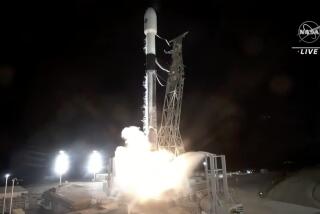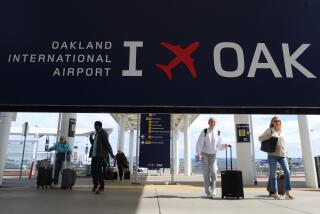Airport Plan May Pit Navy Against San Diego Civilians
- Share via
SAN DIEGO — In describing the economic and social relationship between the Navy and the San Diego region, the secretary of the Navy last week reached for a business comparison.
“The Navy has been the anchor tenant of the city and county of San Diego for many, many years,” Donald Winter said.
If so, the two sides seem headed for the biggest landlord-tenant dispute in their history, over the issue of a new civilian airport.
For half a century, civic leaders have said the region’s economic future is imperiled by an airport that is convenient to downtown but woefully undersized.
But finding a site for a new airport is an exercise in NIMBYism.
Now a consensus appears to be coalescing around the idea that, if San Diego is to replace Lindbergh Field, the new airport will have to be at Miramar Marine Corps Air Station, North Island Naval Air Station or Camp Pendleton, all of which have runways and lots of open space.
Miramar, smack in the middle of the city, is the clear favorite.
The mantra is joint use for civilian and military aircraft, even though the Navy and Marine Corps have repeatedly, emphatically, unequivocally, rejected the idea.
Today, the San Diego County Regional Airport Authority, created in 2001 to slice the Gordian knot, is to release its analysis of the three military sites.
The authority has set a June 5 deadline to pick a site that could be submitted to voters in November.
Technically, the vote is only advisory, but if voters say yes to a site, the airport authority will start gathering the billions of dollars needed to build a new airport.
Some local officials believe that, if the public endorses, say, Miramar, the military will cave in or Congress will order the military to accept the joint use concept, which is in limited use at other military bases.
So when Winter visited here, part of his mission was to convince the locals that they are wasting their time on Miramar, North Island and Pendleton.
The debate will only “create a lot of collateral damage between the Navy-Marine Corps team and the citizens of San Diego,” Winter told several hundred members of the San Diego Military Advisory Council assembled for breakfast at the Marine Corps Recruit Depot, where the roar of planes from Lindbergh could be heard.
Steve Erie, a professor of political science at UC San Diego who thinks joint use is worth considering, said the city and the military seem to be playing “a game of chicken.”
There is no indication that Winter’s comments changed any minds on the authority, where the majority appears to favor Miramar.
“When I got into this three years ago, we were looking for the best location,” said authority member William Lynch. “Now I realize that Miramar is the only location. It has 23,000 acres; we need, at most, 5,000.”
Through nearly all of its history, San Diego has depended on the infrastructure kindness of strangers. Without Los Angeles International Airport, the ports of Los Angeles and Long Beach, and the Los Angeles-based Metropolitan Water District of Southern California, San Diego County would not be nearly as populous or prosperous, Erie said.
While San Diego has fiddled, other areas have built airports that can accommodate international passenger flights and large-scale cargo flights. Lindbergh Field is a quarter of the size of airports in Oakland, St. Louis, Cleveland and Tampa, Fla., each of which serves regions of about the same size.
Lindbergh Field, with 200,000 arrivals and departures annually, is the busiest one-runway airport in the country. At some point, it will reach capacity.
Hemmed in by the Marine Corps Recruit Depot, Lindbergh lacks room for a second runway or a longer one.
At 9,400 feet, the runway cannot accommodate planes bound for the markets or tourist destinations of Asia.
In theory, five locations are still in the running.
In addition to the three military sites, authority members have identified vacant land near the rural communities of Boulevard and Campo and a spot in the Imperial Valley desert.
The former is 69 miles from downtown San Diego, the latter 104 miles, making the chances of public acceptance of either site somewhat remote.
Winter, a former president of Northrop Grumman Corp.’s Missiles System sector, repeated the theme that decades of Navy and Marine Corps brass have sounded: Mixing jets and helicopters with commercial airlines is too dangerous and would hurt military readiness.
“The safety issue and mission implications are just overwhelming,” he said.
Rep. Duncan Hunter (R-El Cajon), chairman of the House Armed Services Committee, is not waiting for the November vote. He added language in the defense spending bill approved last week that would ban civilian use of any local military airports, earning him a rare rebuke from the editorial page of the San Diego Union-Tribune.
Disputes between the city and the military, though not common, are not unprecedented. In 1980s, then-Mayor Pete Wilson, a former Marine, was furious when the Navy condemned land on the edge of Balboa Park for a new hospital after the measure failed to win voter approval.
The airport dispute comes at a delicate time for the Navy and City Hall.
The two sides are negotiating the future of Navy-owned property along the Embarcadero, a 15-acre site touted as the last piece of prime downtown waterfront real estate.
Once the analysis of the three military sites is released today, the airport authority plans a series of public hearings.
Already videos are being shown in the airport warning of increased ticket prices and canceled flights if a bigger airport is not built soon.
“We’ve just got to get the people and the politicians to focus on this issue,” Lynch said. “This community is between a rock and a hard place. We’re all patriotic but.... “
More to Read
Sign up for Essential California
The most important California stories and recommendations in your inbox every morning.
You may occasionally receive promotional content from the Los Angeles Times.









